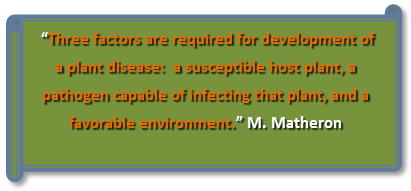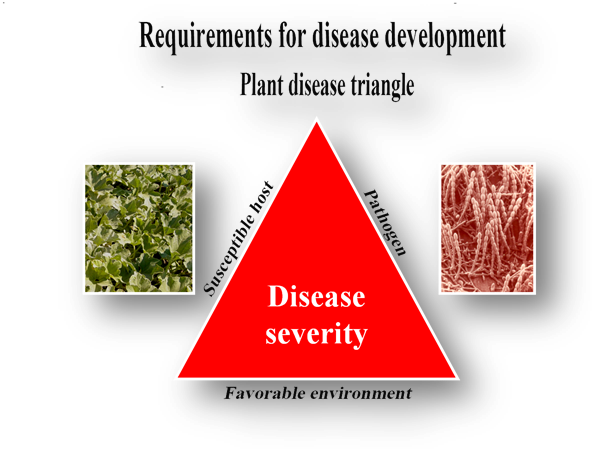
Three factors are required for development of a plant disease: a susceptible host
plant, a pathogen capable of infecting that plant, and a favorable environment.
Temperature and moisture are aspects of the environment that critically affect the
development and severity of diseases caused by bacterial and fungal pathogens. A
plant disease caused by these types of pathogens will not occur if temperature and/or
moisture levels prohibit the pathogen from interacting with the host plant to cause
disease. This explains why some diseases only appear during a particular time period
during the growing season of a particular crop. For example, Fusarium wilt on lettuce
in the desert is found primarily during the fall, but not during the winter months.
Why? Because soil temperatures in the fall, but not the winter months, favor the
growth of the pathogen and disease development. Also, downy mildew on winter vegetables
such as lettuce, cruciferous crops, onions, and spinach is usually a concern in
late autumn, winter, and early spring, but only when periods of leaf wetness caused
by rainfall and dew are present. Periods of high humidity and leaf wetness are essential
for the downy mildew pathogens to grow, proliferate, and cause disease. The generally
dry conditions prevalent in the desert benefit growers by inhibiting foliar diseases
caused by bacteria and many fungi. These organisms can flourish in regions receiving
abundant rainfall. Growers can’t control the weather; however, they do have control
over irrigation practices, which in some cases can influence the severity of vegetable
crop diseases. For instance, the severity of Sclerotinia drop on lettuce can be
increased by over-irrigation, especially if this results in prolonged wetting of
the bed top. Also, during periods of rainfall and high humidity, sprinkler irrigation
can extend the duration of high foliar moisture and thus increase the severity of
downy mildew.

Disease Triangle
Click picture to listen to Mike's update





